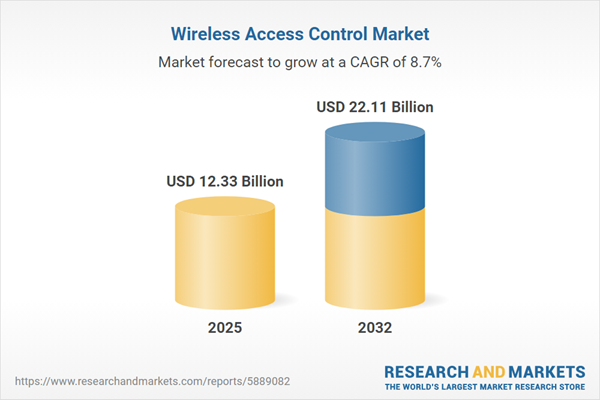Speak directly to the analyst to clarify any post sales queries you may have.
Wireless access control systems are reshaping enterprise security strategy, enabling organizations to unify facility management, support compliance efforts, and increase adaptability. As enterprises invest in flexible, centralized solutions, they are driving modernization across operational and security infrastructure.
Market Snapshot: Wireless Access Control Market and Growth Trends
The wireless access control market is advancing rapidly, paralleling ongoing enterprise digital transformation. Market participants are reporting increased demand as organizations look for scalable, integrated solutions that deliver centralized oversight. The adoption of software-defined and cloud-enabled systems allows companies to replace legacy hardware swiftly, supporting compliance and operational agility. There is heightened interest in integrating wireless access control with broader building management systems, which strengthens governance and risk reduction initiatives. As regulatory expectations evolve and there is a growing trend toward unified infrastructure, the sector is experiencing a surge of innovation and investment. Organizations are actively realigning security strategies to address dynamic regulatory and operational requirements.
Scope & Segmentation of the Wireless Access Control Market
This report presents a detailed examination of the wireless access control market, focusing on the primary segments and influential adoption drivers. The segmentation provides senior decision-makers with the clarity and evidence needed to make strategic investments confidently, reflecting core operational, technological, and geographic factors.
- Component: Access controllers, electronic locks, readers, and authentication tokens are at the foundation of deployment, while robust software platforms, offered both on-premises and in the cloud, deliver management and policy control. Professional service offerings enable efficient integration and performance optimization across varied facility types.
- Deployment: Both cloud-based and on-premises models accommodate organizational demands for scalability, flexibility, governance, and long-term operational stability.
- Authentication Type: Technologies such as biometrics (including fingerprint and facial recognition), RFID, smart cards, and PIN or password credentials enable organizations to apply customizable security and address compliance needs.
- Access Technology: Integration options include Bluetooth, NFC, RFID, Wi-Fi, and Zigbee—each supporting strong interoperability and broadening applicability for diverse facility environments.
- Application: Solutions are tailored for commercial premises, healthcare, manufacturing, and residential sectors, each driven by distinct compliance and workflow requirements.
- End User: Deployment patterns are shaped by sector needs in financial services, defense, government, insurance, retail, e-commerce, telecommunications, and technology, with a focus on risk management and infrastructure responsiveness.
- Geographic Regions: Coverage includes the Americas, Europe, Asia-Pacific, and the Middle East & Africa. Regional segmentation factors in local compliance and technology maturity, shaping adoption and organizational readiness.
- Leading Companies: Industry leaders include ASSA ABLOY AB, Allegion plc, Johnson Controls International plc, Honeywell International Inc., Schneider Electric SE, Robert Bosch GmbH, Dormakaba Holding AG, Axis Communications AB, SALTO Systems S.L., and Suprema Inc.
Key Takeaways for Senior Decision-Makers
- Wireless access control consolidates security oversight, supporting new implementations as well as seamless upgrades, resulting in greater operational agility for complex enterprises.
- Biometric and mobile authentication provide compliance alignment and enhance organizational security, ensuring security measures adapt to regulatory changes.
- Cloud-based management enables real-time facility monitoring and accelerates incident response—a benefit for distributed and multi-site organizations.
- Integration with whole-building systems increases transparency by supporting enterprise-wide management of security, energy, and maintenance services.
- Collaboration among stakeholders fosters features such as predictive maintenance and improved compliance support, enhancing resilience and enterprise value.
Tariff Impact: Effects of U.S. Trade Measures
Recent adjustments to U.S. tariffs have increased hardware acquisition costs for wireless access control components. To counter these pressures, organizations are increasingly deploying software-centric solutions and adopting subscription-based models. This change accelerates supply chain agility and simplifies sourcing, supporting improved continuity planning and enhancing risk management as market conditions develop.
Methodology & Data Sources
The findings in this report are drawn from in-depth interviews with industry executives, specialist surveys, and critical review of compliance demands and emerging market trends. This robust methodology guarantees actionable insights for facilities security and operational leaders.
Why This Report Matters
- Provides the strategic foundation required to shape effective wireless access control investment and deployment initiatives, backed by detailed market segmentation and analysis.
- Empowers organizations by clarifying procurement and compliance approaches across sectors and global regions, strengthening operational planning.
- Supports IT, operations, and risk leaders in improving facility efficiency, resulting in stronger oversight and adaptive infrastructure management.
Conclusion
organizations investing in wireless access control gain scalable, adaptive security aligned with enterprise operations. This report enables senior leaders to anticipate compliance changes and chart an informed course through evolving security priorities.
Additional Product Information:
- Purchase of this report includes 1 year online access with quarterly updates.
- This report can be updated on request. Please contact our Customer Experience team using the Ask a Question widget on our website.
Table of Contents
3. Executive Summary
4. Market Overview
7. Cumulative Impact of Artificial Intelligence 2025
Companies Mentioned
The companies profiled in this Wireless Access Control market report include:- ASSA ABLOY AB
- Allegion PLC
- Johnson Controls International PLC
- Honeywell International Inc.
- Schneider Electric SE
- Robert Bosch GmbH
- Dormakaba Holding AG
- Axis Communications AB
- SALTO Systems S.L.
- Suprema Inc.
Table Information
| Report Attribute | Details |
|---|---|
| No. of Pages | 196 |
| Published | November 2025 |
| Forecast Period | 2025 - 2032 |
| Estimated Market Value ( USD | $ 12.33 Billion |
| Forecasted Market Value ( USD | $ 22.11 Billion |
| Compound Annual Growth Rate | 8.7% |
| Regions Covered | Global |
| No. of Companies Mentioned | 11 |









